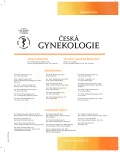Complications arising out of insufficient reporting of clinical data to the pathologist investigating placentas
Authors:
Š. Hadravská 1,2; M. Dubová 1,2; P. Mukenšnabl 1; O. Daum 1,2
Authors‘ workplace:
Šiklův ústav patologie LF UK a FN, Plzeň, přednosta prof. MUDr. M. Michal
1; Bioptická laboratoř, s. r. o., Plzeň, vedoucí lékařka prof. MUDr. A. Skálová, CSc.
2
Published in:
Ceska Gynekol 2017; 82(3): 197-201
Overview
Objective:
To inform gynecologists-obstetricians about the problems associated with pathological examination of placentas, with special regard to the possibility of crucial role of complete and relevant clinical data in establishing the correct pathological diagnosis.
Design:
Case report and overview of the problems associated with examination of placentas by pathologist.
Setting:
Sikl´s Institute of Pathology, Faculty Hospital and Medical Faculty Pilzen of the Charles University in Prague; Biopticka laborator, s.r.o., Pilzen.
Methods:
Own observation in the setting of routine pathological examination.
Results:
Case report representing a typical complication resulting from insufficient interdisciplinary communication describes a case of unsatisfactory result of pathological investigation of placenta due to the missing clinical information about complications of the late phase of pregnancy which eventually led to intrauterine death of the fetus. Due to the absence of the clinical information of paramount importance, the initial investigation of placenta was untargeted and thus imperfect. Therefore, the primary investigation of the placenta did not reveal pathological changes responsible for the complications of pregnancy. It was only the revision of material necessitated by the information additionally conveyed by gynecologist-obstetrician leading to the final correct pathological diagnosis, which even averted the possibility of serious forensic consequences.
Conclusion:
The basic prerequisite for proper pathological examination of placenta is sharing the available clinical data with the pathologist performing the morphological investigation, mainly focusing on complications of pregnancy. Lack of such information causes examination of placenta more difficult and sometimes even unable to interpret, as the interpretation of morphological changes of placenta have to interpreted in the context of clinical data on the course of pregnancy. Regarding the extreme emotional and possibly even legal consequences of lethal complications of pregnancy or delivery, the correct pathological diagnosis may be of crucial importance.
Keywords:
placenta, clinical information, examination of the placenta, send placenta to pathology
Sources
1. Gordinj, SJ., Dahlstrom, JE., Khong,TY., et al. Histopathological examination of the placenta: key issues for pathologists and obstetricians. Pathology, 2008, 40, 2, p. 176–179.
2. Hargitai, B., Marton, T., Cox, PM. Examination of the human placenta. J Clin Pathol, 2004, 57, 8, p. 785–792.
3. Hornychová, H., Matějková, A., Kacerovský, M. Praktické poznámky k vyšetření placenty ve druhém a třetím trimestru gravidity. Ces Patol, 2015, 51, 2, s. 74–79.
4. Jaiman, S. Gross examination of the placenta and its importance in evaluation an unexplained intrauterine fetal demise. J Fetal Med, 2015, 2, 3, p. 113–120.
5. Kraus, FT., Redline RW., Gersell DJ., et al. Atlas of nontumor pathology. Placental pathology. 1. ed. Washington, DC: ARP and AFIP, 2004, 331 p.
6. Roberts, DJ. Placental pathology, a survival guide. Arch Pathol Lab Med, 2008, 132, 4, p. 641-651.
7. Spencer, K., Khong, TY. Conformity to guidelines for pathologic examination of the placenta. Rates of submission and listing of clinical indications. Arch Pathol Lab Med, 2003, 127, 2, p. 205–207.
Labels
Paediatric gynaecology Gynaecology and obstetrics Reproduction medicineArticle was published in
Czech Gynaecology

2017 Issue 3
Most read in this issue
- Complications tension-free vaginal tape surgery
- Current FIGO staging classification for cancer of ovary, fallopian tube and peritoneum
- Hirsutism
- Retrospective analysis of monochorionic twin pregnancies born in the Institute for the Care of Mother and Child between 2012–2015
